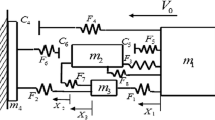Abstract
This paper investigates the usability of spring which exhibit nonlinear force-deflection characteristic in the area of mathematical modeling of vehicle crash. We present a method which allows us to obtain parameters of the spring-mass model basing on the full-scale experimental data analysis. Since vehicle collision is a dynamic event, it involves such phenomena as rebound and energy dissipation. Three different spring unloading scenarios (elastic, plastic, and elasto-plastic) are covered and their suitability for vehicle collision simulation is evaluated. Subsequently we assess which of those models fits the best to the real car’s behavior not only in terms of kinematic responses but also in terms of energy distribution.
Similar content being viewed by others
References
Pawlus W, Nielsen JE, Karimi HR, Robbersmyr KG (2010) Mathematical modeling and analysis of a vehicle crash. In: The 4th European computing conference, Bucharest, Romania
Pawlus W, Nielsen JE, Karimi HR, Robbersmyr KG (2010) Development of mathematical models for analysis of a vehicle crash. WSEAS Trans Appl Theor Mech 5(2):156–165
Pawlus W, Nielsen JE, Karimi HR, Robbersmyr KG (2010) Further results on mathematical models of vehicle localized impact. In: The 3rd international symposium on systems and control in aeronautics and astronautics, Harbin, China
Karimi HR, Robbersmyr KG (2010) Wavelet-based signal analysis of a vehicle crash test with a fixed safety barrier. In: WSEAS 4th European computing conference, Bucharest, Romania
Šušteršič G, Grabec I, Prebil I (2007) Statistical model of a vehicle-to-barrier collision. Int J Impact Eng 34(10):1585–1593
Trusca D, Soica A, Benea B, Tarulescu S (2009) Computer simulation and experimental research of the vehicle impact. WSEAS Trans Comput 8(1):1185–1194
Vangi D (2009) Energy loss in vehicle to vehicle oblique impact. Int J Impact Eng 36(3):512–521
Giavotto V, Puccinelli L, Borri M, Edelman A, Heijer T (1983) Vehicle dynamics and crash dynamics with minicomputer. Comput Struct 16(1):381–393
Harmati IA, Rovid A, Szeidl L, Varlaki P (2008) Energy distribution modeling of car body deformation using LPV representations and fuzzy reasoning. WSEAS Trans Syst 7(1):1228–1237
Omar T, Eskandarian A, Bedewi N (1998) Vehicle crash modelling using recurrent neural networks. Math Comput Model 28(9):31–42
Pawlus W, Nielsen JE, Karimi HR, Robbersmyr KG (2010) Comparative analysis of vehicle to pole collision models established using analytical methods and neural networks. In: The 5th IET international system safety conference, Manchester, UK
Várkonyi-Kóczy AR, Rövid A, Várlaki P (2004) Intelligent methods for car deformation modeling and crash speed estimation. In: The 1st Romanian–Hungarian joint symposium on applied computational intelligence, Timisoara, Romania
van der Laan E, Veldpaus F, de Jager B, Steinbuch M (2008) LPV modeling of vehicle occupants. In: AVEC ’08 9th international symposium on advanced vehicle control, Kobe, Japan
Elmarakbi AM, Zu JW (2006) Crash analysis and modeling of two vehicles in frontal collisions using two types of smart front-end structures: an analytical approach using IHBM. Int J Crashworthiness 11(5):467–483
Fang H, Rais-Rohani M, Liu Z, Horstemeyer MF (2005) A comparative study of metamodeling methods for multiobjective crashworthiness optimization. Comput Struct 83(25–26):2121
Conroy C, Tominaga GT, Erwin S, Pacyna S, Velky T, Kennedy F, Sise M, Coimbra R (2008) The influence of vehicle damage on injury severity of drivers in head-on motor vehicle crashes. Accident Anal Prev 40(4):1589–1594
Niu Y, Shen W, Stuhmiller JH (2007) Finite element models of rib as an inhomogeneous beam structure under high-speed impacts. Med Eng Phys 29(7):788–798
Kim JK, Ulfarssonn GF, Shankar VN, Mannering FL (2010) A note on modeling pedestrian-injury severity in motor-vehicle crashes with the mixed logit model. Accident Anal Prev 42(6):1751–1758
Ma J, Kockelman KM, Damien P (2008) A multivariate Poisson-lognormal regression model for prediction of crash counts by severity, using Bayesian methods. Accident Anal Prev 40(3):964–975
Robbersmyr KG (2004) Calibration test of a standard ford fiesta 1.1l, model year 1987, according to NS - EN 12767. Technical Report 43/2004, Agder Research, Grimstad
Huang M (2002) Vehicle crash mechanics. CRC Press, Boca Raton
Author information
Authors and Affiliations
Corresponding author
Rights and permissions
About this article
Cite this article
Pawlus, W., Karimi, H.R. & Robbersmyr, K.G. Mathematical modeling of a vehicle crash test based on elasto-plastic unloading scenarios of spring-mass models. Int J Adv Manuf Technol 55, 369–378 (2011). https://doi.org/10.1007/s00170-010-3056-x
Received:
Accepted:
Published:
Issue Date:
DOI: https://doi.org/10.1007/s00170-010-3056-x




